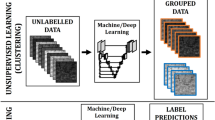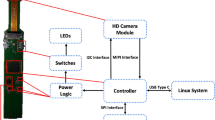Abstract
Dental biometrics utilizes the evidence divulged by radiographic dental images for human identification. Dental biometrics is commonly used to recognize dead individuals by comparing their before death (ante-mortem) and after death (post-mortem) dental images with the attributes such as tooth contours, restorations, number and shape of the teeth, and relative positions. In recent years, conventional local image descriptors and deep learning based features have shown excellent performances in different applications due to their excellent flexibility and capacity. Regardless of dental biometrics’ potential, the efficacy of human identification using dental radiographic images with advanced machine learning methods has not been adequately analyzed so far. In this paper, we investigate various facets of conventional hand-crafted microtextural (12 different descriptors) and deep learning-based features (8 different architectures) for dental biometrics. The dental features of single tooth images (segmented with Mask RCNN) are extracted and the features are matched with various distance functions and fusion techniques. Also, pretraining and fine-tuning transfer learning methods are employed while evaluating deep learning based methods. The empirical analysis, performed on a dataset of 100 dental images and fully reproducible, demonstrates the potential of local microtextural and deep learning tools for dental biometrics. The experiments showed that deep learning based methods with majority voting outperform other methods where Inception architecture has higher identification accuracy. All of the deep learning based methods have at least than 96% Rank-1 accuracy with majority voting.







Similar content being viewed by others
References
Abdel-Mottaleb M, Nomir O, Nassar DE, Fahmy G, Ammar HH (2003) Challenges of developing an automated dental identification system. In: IEEE 46th Midwest symposium on circuits and systems, vol 1, pp 411–414
Ahonen T, Hadid A, Pietikainen M (2006) Face description with local binary patterns: application to face recognition. IEEE Trans Pattern Anal Mach Intell 28(12):2037–2041
Ahonen T, Rahtu E, Ojansivu V, Heikkila J (2008) Recognition of blurred faces using local phase quantization. In: ICPR, pp 1–4
Ajaz A, Kathirvelu D (2013) Dental biometrics: Computer aided human identification system using the dental panoramic radiographs. In: IEEE international conference on communications and signal processing, pp 717–721
Atheeswaran A, Karunya R, Amir A (2014) Human identification using dental biometrics. Int J Appl Eng Res 9:4428–4433
Älberg J-V, Goodwin M (2016) Automated dental identification with lowest cost path-based teeth and jaw separation. Scand J Forensic Sci 22(2):44–56
BS, RN (2020) Transfer learning based automatic human identification using dental traits- an aid to forensic odontology. J Forensic Legal Med 76:102066
Banday M, Mir AH (2019) Dental biometric identification system using ar model. In: TENCON, pp 2363–2369
Barboza E, Marana A, Tostes Oliveira D (2012) Semiautomatic dental recognition using a graph-based segmentation algorithm and teeth shapes features, pp 348–353
Bosch A, Zisserman A, Munoz X (2007) Representing shape with a spatial pyramid kernel. In: aCM international conference on Image and video retrieval, pp 401–408
Chan C-H, Kittler J, Messer K (2007) Multi-scale local binary pattern histograms for face recognition. In: Lee S-W, Li S Z (eds) Advances in Biometrics. Springer, pp 809–818
Chollet F (2016) Xception: Deep learning with depthwise separable convolutions. CoRR arXiv:1610.023571610.02357
Cui Z, Li C, Wang W (2019) Toothnet: Automatic tooth instance segmentation and identification from cone beam ct images. In: 2019 IEEE/CVF Conference on Computer Vision and Pattern Recognition (CVPR), pp 6361–6370
Dalal N, Triggs B (2005) Histograms of oriented gradients for human detection. In: CVPR, vol 1, IEEE, pp 886–893
Deng J, Dong W, Socher R, Li L-J, Li K, Fei-Fei L (2009) ImageNet: A Large-Scale Hierarchical Image Database. In: CVPR09
Dentistry – designation system for teeth and areas of the oral cavity. Standard, Universal Images Group Medical Images (2016)
Dubey SR (2019) Face retrieval using frequency decoded local descriptor. Multimed Tools Appl 78(12):16411–16431
Fahmy G, Nassar D, Haj-Said E, Chen H, Nomir O, Zhou J, Howell R, Ammar HH, Abdel-Mottaleb M, Jain AK (2005) Towards an automated dental identification system. J Electron Imaging 14(4):43018–43018
Fan F, Ke W, Wu W, Tian X, Lyu T, Liu Y, Liao P, Dai X, Chen H, Deng Z (2020) Automatic human identification from panoramic dental radiographs using the convolutional neural network. Forensic Sci Int 314:110416
Fan Y, Beare R, Matthews H, Schneider P, Kilpatrick N, Clement J, Claes P, Penington A, Adamson C (2018) Marker-based watershed transform method for fully automatic mandibular segmentation from cbct images. Dentomaxillofacial Radiol 48:20180261. https://doi.org/10.1259/dmfr.20180261
Frejlichowski D, Czapiewski P (2013) An application of the curvature scale space shape descriptor for forensic human identification based on orthopantomograms, vol 8104, pp 67–76
Frejlichowski D, Wanat R (2011) Extraction of teeth shapes from orthopantomograms for forensic human identification. In: Computer analysis of images and patterns, lecture notes in computer science, vol 6855. Springer, Berlin, pp 65–72
Gurses A, Oktay AB (2020) Human identification with panoramic dental images using mask r-cnn and surf. In: 2020 5th international conference on computer science and engineering (UBMK), pp 232–237
HA, Zoroofi R, Shirani G (2009) Rapid automatic segmentation and visualization of teeth in ct-scan data. J Appl Sci:9. https://doi.org/10.3923/jas.2009.2031.2044
He K, Zhang X, Ren S, Sun J (2015) Deep residual learning for image recognition. CoRR. arXiv:1512.033851512.03385
Heinrich A, Güttler F, Schenkl S, Wagner R, Teichgräber U (2020) Automatic human identification based on dental x-ray radiographs using computer vision. Sci Rep 10(1):3801
Hofer M, Marana AN (2007) Dental biometrics: Human identification based on dental work information. In: SIBGRAPI, pp 281–286
Huang G, Liu Z, Weinberger KQ (2016) Densely connected convolutional networks. CoRR arXiv:1608.069931608.06993
Hwang J-J, Jung Y-H, Cho B-H, Heo M-S (2019) An overview of deep learning in the field of dentistry. Imaging Sci Dentist 49:1. https://doi.org/10.5624/isd.2019.49.1.1
Iandola FN, Moskewicz MW, Ashraf K, Han S, Dally WJ, Keutzer K (2016) Squeezenet: Alexnet-level accuracy with 50x fewer parameters and < 1mb model size. CoRR arXiv:1602.07360
Jader G, Fontineli J, Ruiz M, Lima K, Pithon M, Oliveira L (2018) Deep instance segmentation of teeth in panoramic x-ray images, pp 400–407
Jader G, Oliveira L, Pithon M (2018) Automatic segmenting teeth in x-ray images: Trends, a novel data set, benchmarking and future perspectives. Expert Syst Appl:107. https://doi.org/10.1016/j.eswa.2018.04.001
Jain AK, Chen H (2004) Matching of dental x-ray images for human identification. Pattern Recogn 37(7):1519–1532
Joseph LJ, George LB, Shabna GU, Susmi I, Santhi N (2016) Teeth feature extraction and matching for human identification using morphological skeleton transform. In: 2016 International Conference on Energy Efficient Technologies for Sustainability (ICEETS), pp 802–807
Kannala J, Rahtu E (2012) Bsif: Binarized statistical image features. In: ICPR2012, pp 1363–1366
Krizhevsky A, Sutskever I, Hinton GE (2012) Imagenet classification with deep convolutional neural networks. In: Pereira F, Burges C J C, Bottou L, Weinberger KQ (eds) Advances in neural information processing systems, vol 25. Curran Associates, Inc., pp 1097–1105
Lai Y, Fan F, Wu Q, Ke W, Liao P, Deng Z, Chen H, Zhang Y (2020) Lcanet: Learnable connected attention network for human identification using dental images. IEEE Trans Med Imaging:1–1. https://doi.org/10.1109/TMI.2020.3041452
Lan R, Zhou Y, Tang YY (2016) Quaternionic local ranking binary pattern: A local descriptor of color images. IEEE Trans Image Process 25(2):566–579
Lee C, Lim S-H, Huh K-H, Han S-S, Kim J-E, Heo M-S, Yi W-J, Lee S-S, Choi S-C (2019) Performance of dental pattern analysis system with treatment chronology on panoramic radiography. Forensic Sci Int 299:229–234
Lee J-H, Han S-S, Kim Y, Lee C, Kim I (2019) Application of a fully deep convolutional neural network to the automation of tooth segmentation on panoramic radiographs. Oral Surgery, Oral Medicine, Oral Pathology and Oral Radiology
Lin P-L, Lai Y-H, Huang P-W (2012) Dental biometrics: human identification based on teeth and dental works in bitewing radiographs. Pattern Recogn 45(3):934–946
Lin PL, Lai YH, Huang PW (2010) An effective classification and numbering system for dental bitewing radiographs using teeth region and contour information. Pattern Recogn 43(4):1380–1392
Lorton L, Rethman M, Friedman R (1988) Computer-assisted postmortem identification (capmi) system: A computer-based identification program. J Forensic Sci 33:977–984
Matsuda S, Miyamoto T (2020) Personal identification with orthopantomography using simple convolutional neural networks: a preliminary study. Sci Rep:10
Miki Y, Muramatsu C, Hayashi T, Zhou X, Hara T, Katsumata A, Fujita H (2017) Tooth labeling in cone-beam ct using deep convolutional neural network for forensic identification, pp 101343E
McGivney J et al WinIDsoftware. http://www.winid.com, Accessed: 2021-06-01
Nomir O, Abdel-Mottaleb M (2007) Human identification from dental x-ray images based on the shape and appearance of the teeth. IEEE Trans Inf Forensic Secur 2:188–197. https://doi.org/10.1109/TIFS.2007.897245
Oktay AB (2017) Human identification with dental panoramic radiographic images. IET Biometr 7(4):349–355
Petju M, Suteerayongprasert A, Thongpud R, Hassiri K (2007) Importance of dental records for victim identification following the indian ocean tsunami disaster in Thailand. Public Health 121(4):251–257
Reesu GV, Woodsend B, Mnica S, Revie GF, Brown NL, Mossey PA (2020) Automated identification from dental data (autoidd): a new development in digital forensics. Forensic Sci Int 309:110218
Shah N, Bansal N, Logani A (2014) Recent advances in imaging technologies in dentistry. World J Radiol 6:794–807. https://doi.org/10.4329/wjr.v6.i10.794
Simonyan K, Zisserman A (2014) Very deep convolutional networks for large-scale image recognition. arXiv:1409.1556
Szegedy C, Wei Liu, Yangqing Jia, Sermanet P, Reed S, Anguelov D, Erhan D, Vanhoucke V, Rabinovich A (2015) Going deeper with convolutions. In: 2015 IEEE Conference on Computer Vision and Pattern Recognition (CVPR), pp 1–9
Tan X, Triggs B (2007) Enhanced local texture feature sets for face recognition under difficult lighting conditions. In: International workshop on analysis and modeling of faces and gestures, Springer, pp 168–182
Tuzoff D, Tuzova L, Bornstein M, Krasnov A, Kharchenko M, Nikolenko S, Sveshnikov M, Bednenko G (2019) Tooth detection and numbering in panoramic radiographs using convolutional neural networks. Dentomaxillofacial Radiol 48:20180051
Utsuno DDS (2019) Victim identification in large-scale disasters using dental findings. IATSS Res:43. https://doi.org/10.1016/j.iatssr.2019.06.005
Vijayakumari B, Kirubalini RR, Manisha CR (2020) Cadaver identification with dental radiographs using isoperimetric and nodal graph approach. IET Biometr 9(1):38–45
Vu N-S, Caplier A (2010) Face recognition with patterns of oriented edge magnitudes. In: Daniilidis K, Maragos P, Paragios N (eds) ECCV. Springer, Berlin, pp 313–326
Wang Y-J, Liu S, Wang G, Liu Y (2018) Accurate tooth segmentation with improved hybrid active contour model. Phys Med Biol:64. https://doi.org/10.1088/1361-6560/aaf441
Wu J, Rehg JM (2011) Centrist: A visual descriptor for scene categorization. IEEE Trans Pattern Anal Mach Intell 33(8):1489–1501
Wu Q, Fan F, Liao P, Lai Y, Ke W, Du W, Chen H, Deng Z, Zhang Y (2021) Human identification with dental panoramic images based on deep learning. Sens Imaging:22. https://doi.org/10.1007/s11220-020-00326-y
Zhang L, Zhou Z, Li H (2012) Binary gabor pattern: An efficient and robust descriptor for texture classification. In: 2012 19th IEEE international conference on image processing, pp 81–84
Zhang X, Zhou X, Lin M, Sun J (2017) Shufflenet: An extremely efficient convolutional neural network for mobile devices. arXiv:1707.01083
Zhang Z, Ong SH, Zhong X, Foong KWC (2016) Efficient 3d dental identification via signed feature histogram and learning keypoint detection. Pattern Recogn 60:189–204
Zhong X, Yu D, Wong YS, Sim T, Lu WF, Foong KWC, Cheng H-L (2013) 3d dental biometrics: Alignment and matching of dental casts for human identification. Comput Ind 64(9):1355–1370. Special Issue: 3D Imaging in Industry
Author information
Authors and Affiliations
Corresponding author
Additional information
Publisher’s note
Springer Nature remains neutral with regard to jurisdictional claims in published maps and institutional affiliations.
Z. Akhtar and A. Gurses contributed equally.
Rights and permissions
About this article
Cite this article
Oktay, A.B., Akhtar, Z. & Gurses, A. Dental biometric systems: a comparative study of conventional descriptors and deep learning-based features. Multimed Tools Appl 81, 28183–28206 (2022). https://doi.org/10.1007/s11042-022-12019-7
Received:
Revised:
Accepted:
Published:
Issue Date:
DOI: https://doi.org/10.1007/s11042-022-12019-7




